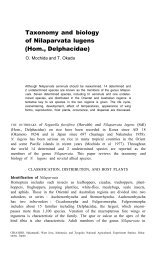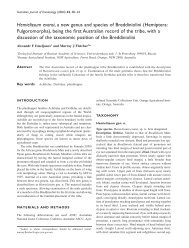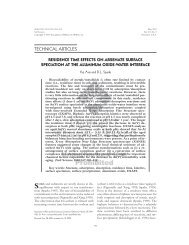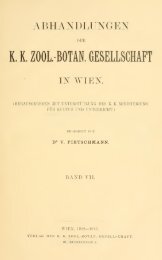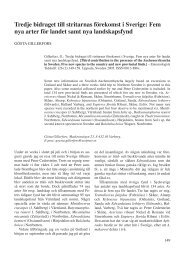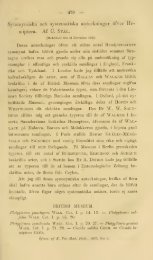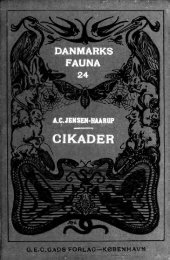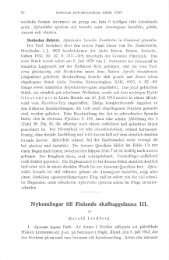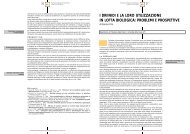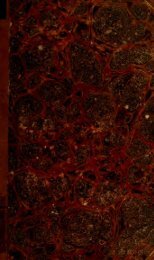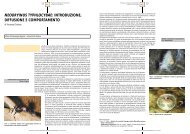Tree-of-heaven Ailanthus altissima (Simaroubaceae) Introduction ...
Tree-of-heaven Ailanthus altissima (Simaroubaceae) Introduction ...
Tree-of-heaven Ailanthus altissima (Simaroubaceae) Introduction ...
You also want an ePaper? Increase the reach of your titles
YUMPU automatically turns print PDFs into web optimized ePapers that Google loves.
Eucryptorrhynchus brandti<br />
(Coleoptera: Curculionidae), a<br />
potential biological control agent<br />
<strong>of</strong> tree‐<strong>of</strong>‐<strong>heaven</strong><br />
Tom McAvoy tmcavoy@vt.edu*,<br />
Amy Snyder*, Nathan Herrick, and Scott Salom*<br />
*Department <strong>of</strong> Entomology<br />
College <strong>of</strong> Agriculture and Life Sciences<br />
Virginia Tech<br />
Blacksburg, VA<br />
Biological Control <strong>of</strong> Northeastern Weeds – 2013 Cooperators<br />
Meeting,<br />
Feb. 19, 2013, Trenton, NJ<br />
Known distribution <strong>of</strong> tree‐<strong>of</strong>‐<strong>heaven</strong> in the US.<br />
<strong>Tree</strong>‐<strong>of</strong>‐<strong>heaven</strong> <strong>Ailanthus</strong> <strong>altissima</strong><br />
(<strong>Simaroubaceae</strong>)<br />
Native distribution<br />
Non‐native distribution<br />
Worldwide distribution <strong>of</strong> A. <strong>altissima</strong> (Kowarik and Sӓumel 2007).<br />
<strong>Introduction</strong> into United States<br />
Two introductions from England as an<br />
ornamental:<br />
o 1784 Philadelphia, PA<br />
o 1820 New York City<br />
California Gold Rush mid‐1800’s direct<br />
from China, used as medicinal<br />
2/20/2013<br />
1
Beneficial Uses<br />
City landscapes, tolerant to air pollution and poor soils<br />
Planted in arid climates, strip mines<br />
Developing countries:<br />
o Firewood<br />
o Pulpwood<br />
o Reforestation<br />
Quassinoids, highly oxygenated triterpenes:<br />
o Medicinal anti‐HIV, antitumor, antimalarial properties<br />
o Insecticidal properties, anti‐feedant, growth<br />
regulation<br />
42 nd most abundant species <strong>of</strong> 128 species<br />
0.2 % <strong>of</strong> live volume in Virginia<br />
Negative Impacts<br />
Invasive in forests and along roadways<br />
Very competitive in newly disturbed areas due to :<br />
o Allelopathic properties<br />
o High seed production and suckering<br />
Displaces native plant species<br />
Roots can damage buildings, sidewalks<br />
Costly to control<br />
5,175 km (3,105 mi) surveyed in Virginia<br />
58% <strong>of</strong> every mile surveyed had at least 1 tree‐<strong>of</strong>‐<strong>heaven</strong> stem<br />
39 tree‐<strong>of</strong>‐<strong>heaven</strong> stems / km (62 stems / mi) (McAvoy et al. 2012)<br />
2/20/2013<br />
2
Management <strong>of</strong> tree‐<strong>of</strong>‐<strong>heaven</strong><br />
Physical – pulling, girdling, digging,<br />
cutting<br />
Chemical ‐ herbicides: glyphosate<br />
(Roundup), triclopyer ester (Garlon)<br />
Biological ‐ fungi and insects<br />
Locations <strong>of</strong> naturally infected and artificially inoculated tree‐<strong>of</strong>‐<br />
<strong>heaven</strong> stands by V. nonalfalfae (Kasson 2012).<br />
Verticillium nonalfalfae Inderb. et al. (formerly V. albo‐<br />
atrum Reinke and Berthold)<br />
Native, soil‐borne, vascular wilt fungus<br />
Resting mycelium can remain dormant<br />
in soil for up to 4 yrs<br />
Long‐range dissemination is limited:<br />
o Wind‐blown leaflets, seeds and insects<br />
Prefers cooler temperatures<br />
Verticillium subspecies or host‐adapted<br />
isolates may attack only certain hosts<br />
Pegg GF, Brady BL. 2002. Verticillium Wilts. Wallingford, UK: CAB International.<br />
Fusarium oxysporum has also been<br />
found to weaken and kill tree‐<strong>of</strong>‐<br />
<strong>heaven</strong><br />
Verticillium nonalfalfae Inderb. et al. (formerly V. albo‐atrum Reinke and Berthold)<br />
Six V. nonalfalfae sites found in Virginia<br />
V. nonalfalfae<br />
Verticillium nonalfalfae<br />
Uninfected<br />
Infected<br />
2/20/2013<br />
3
<strong>Tree</strong>‐<strong>of</strong>‐<strong>heaven</strong> in China is<br />
attacked by:<br />
46 phytophagous arthropods<br />
16 fungi<br />
1 potyvirus<br />
Zheng, H., Wu, Y., Ding, J., Binion, D., Fu, W. and<br />
Reardon, R. (2004), ‘Invasive Plants <strong>of</strong> Asian<br />
Origin Established in the United States and their<br />
Natural Enemies’, Vol 2. Forest Health<br />
Technology Enterprise Team. USDA<br />
Eucryptorrhynchus brandti (Curculionidae)<br />
E. brandti adult feeding<br />
E. brandti egg E. brandti larvae<br />
2/20/2013<br />
4
E. brandti is a pest <strong>of</strong><br />
tree‐<strong>of</strong>‐<strong>heaven</strong> in<br />
China and is actively<br />
controlled<br />
E. brandti larvae E. brandti emergence holes and adult<br />
Eucryptorrhynchus spp. damaged trees in China<br />
Sapindales<br />
Picramniaceae<br />
Rutaceae<br />
Meliaceae<br />
<strong>Simaroubaceae</strong><br />
Leitneriaceae<br />
Sapindaceae<br />
Anacardiaceae<br />
Buseraceae<br />
Cladogram showing hypothesized relationships in the Order<br />
Sapindales (Judd et al. 2002).<br />
<strong>Tree</strong>‐<strong>of</strong>‐<strong>heaven</strong> plantation in Wuhan, Hubei Eucryptorrhynchus spp. emergence<br />
holes in Wuhan, Hubei<br />
Centrifugal Phylogenetic Strategy (Wapshere 1977)<br />
Sapindales<br />
Leitneriaceae,<br />
Picramniaceae,<br />
Meliaceae,<br />
Rutaceae<br />
<strong>Simaroubaceae</strong>:<br />
Castella,<br />
Holacantha,<br />
Simarouba,<br />
<strong>Tree</strong>‐<strong>of</strong>‐<strong>heaven</strong><br />
2/20/2013<br />
5
Native North American, Mexican, and Caribbean<br />
species currently and formerly in <strong>Simaroubaceae</strong><br />
Family<br />
Genus<br />
<strong>Simaroubaceae</strong><br />
Species Common name Distribution<br />
Castela emoryi crucifixion thorn CA, AZ, & Mex.<br />
erecta goatbush TX<br />
polyandra Mex.<br />
Holacantha stewartii Stewart's crucifixion thorn TX<br />
Picrasma antillana bitter ash Carib.<br />
excelsa bitterwood Carib. & Mesoamer.<br />
Quassia amara Amargo, bitter ash, bitterwood Carib.<br />
Simarouba glauca paradise tree FL<br />
Leitneriaceae<br />
tulae aceitillo tree Carib.<br />
Leitneria<br />
Picramniaceae<br />
floridana corkwood AR, FL, GA, MO, TX.<br />
Alvaradoa amorphoides Mexican alvaradoa FL & Mex.<br />
Picramnia pentandra Florida bitterbush FL & Carib<br />
10 Economically important species and 5 Ecologically associated species.<br />
Family<br />
Economically important<br />
Test species Common name<br />
Aceraceae Acer rubrum red maple<br />
Anacardiaceae Mangifera indica Mango<br />
Fabaceae Glycine max Soybean<br />
Fagaceae Quercus alba white oak<br />
Quercus rubra red oak<br />
Juglandaceae Carya glabra pignut hickory<br />
Juglans nigra Black walnut<br />
Magnoliaceae Liriodendron tulipifera tulip poplar<br />
Pinaceae Pinus taeda loblolly pine<br />
Poaceae<br />
Ecologically associated<br />
Zea mays corn<br />
Anacardiaceae Rhus typhina staghorn sumac<br />
Cupressaceae Juniperus virginiana eastern redcedar<br />
Fabaceae Robinia pseudoacacia black locust<br />
Rosaceae Crataegus spp. hawthorne<br />
Prunus serotina black cherry<br />
Adult foliage feeding<br />
Choice Test<br />
1 male and 1 female in each cage, 25oC Allowed to run for 3 days<br />
Newly emerged insects starved for 24 hours<br />
<strong>Tree</strong>‐<strong>of</strong>‐<strong>heaven</strong> and Alvaradoa amorphoides<br />
16 Taxonomically related species tested<br />
Family Test species Common name<br />
<strong>Simaroubaceae</strong> Castela emoryi crucifixion thorn<br />
Simarouba glauca paradise tree<br />
Leitneriaceae Leitneria floridana corkwood<br />
Picramniaceae Alvaradoa amorphoides Mexican alvaradoa<br />
Picramnia pentandra Florida bitterbush<br />
Meliaceae Swietenia mahogoni mahogany<br />
Rutaceae Citrus aurantifolia lime<br />
Citrus aurantium sour orange<br />
Citrus limon lemon<br />
Citrus paradisi grapefruit<br />
Citrus reticulate tangerine<br />
Citrus sinensis sweet orange<br />
Ptelea trifoliata common hoptree<br />
Zanthoxylum americanum northern prickly‐ash<br />
Casimiroa edulis white sapote<br />
Burseraceae Bursera simaruba gumbo limbo<br />
Tests conducted to determine host specificity<br />
• No choice adult foliage feeding<br />
• Choice adult foliage feeding (tree‐<strong>of</strong>‐<br />
<strong>heaven</strong> + nontarget sp.)<br />
negative<br />
Not a host<br />
species<br />
positive<br />
• No choice oviposition<br />
• Larval development<br />
negative<br />
positive<br />
Not a host species Host species<br />
Adult foliage feedingt<br />
No Choice Test<br />
1 male and 1 female in each cage, 25oC Allowed to run for 3 days<br />
Newly emerged insects starved for 24 hours<br />
Alvaradoa amorphoides<br />
2/20/2013<br />
6
Data Collection: Adult Feeding<br />
<strong>Simaroubaceae</strong><br />
Leitneriaceae<br />
Meliaceae<br />
Rutaceae<br />
Measure foliage feeding<br />
with transparent grid<br />
Burseraceae<br />
Aceraceae<br />
Fagaceae<br />
Juglandaceae<br />
Magnoliaceae<br />
Pinaceae<br />
Anacardiaceae<br />
Two choice (one non‐target + tree‐<strong>of</strong>‐<strong>heaven</strong>) adult feeding test (Herrick et al. 2012)<br />
Larval Development Tests<br />
Cupressaceae<br />
Fabaceae<br />
Rosaceae<br />
Poaceae<br />
<strong>Simaroubaceae</strong><br />
Leitneriaceae<br />
Picramniaceae<br />
Meliaceae<br />
Rutaceae<br />
Burseraceae<br />
Aceraceae<br />
Fagaceae<br />
Juglandaceae<br />
Magnoliaceae<br />
Pinaceae<br />
Anacardiaceae<br />
Cupressaceae<br />
Fabaceae<br />
Rosaceae<br />
Poaceae<br />
No choice adult foliage feeding tests vs. tree‐<strong>of</strong>‐<strong>heaven</strong> (65 mm 2 / day) (Herrick et al. 2012)<br />
Development <strong>of</strong> E. brandti larvae (3, 1 st instars per tree) inoculated<br />
into test species<br />
Family<br />
Species No. <strong>of</strong> trees inoculated<br />
<strong>Simaroubaceae</strong><br />
# trees with larval<br />
development after 4 months<br />
<strong>Ailanthus</strong> <strong>altissima</strong> 10 7<br />
Simarouba glauca<br />
Leitneriaceae<br />
10 0<br />
Leitneria floridana<br />
Rutaceae<br />
10 2<br />
Citrus aurantifolia 10 0<br />
C. aurantium 10 0<br />
C. limon 10 0<br />
C. paradisi 10 0<br />
C. reticulata 10 0<br />
C. sinensis 10 0<br />
E. Brandti shows some acceptance <strong>of</strong> Leitneria floridana, corkwood<br />
Globally ranked G3 (vulnerable;<br />
either very rare and local<br />
throughout its range or found<br />
locally in a restricted range)<br />
In Arkansas and Florida<br />
ranked, S3 (very rare and local or<br />
found locally in a restricted range)<br />
In Missouri ranked, S2<br />
(imperiled because <strong>of</strong> rarity)<br />
In Georgia and Texas, S1<br />
(critically imperiled because <strong>of</strong><br />
extreme rarity)<br />
2/20/2013<br />
7
Leitneria floridana, corkwood in Florida Oviposition/Survival tests<br />
Oviposition Tests<br />
52 ovipositing females<br />
were caged on corkwood<br />
for 7 days<br />
Results: 47 females were<br />
alive at end <strong>of</strong> test ‐ no<br />
oviposition occurred<br />
Petition for release <strong>of</strong> E. brandti<br />
May 2011 ‐ Submitted petition to APHIS TAG (Technical<br />
Advisory Group)<br />
October 2012 ‐ received response from TAG reviewers:<br />
o 6 approved release<br />
o 6 requested additional information<br />
o 3 recommended no release<br />
o Chairman denied release due to possible impact on<br />
corkwood<br />
Currently we are doing more work on additional test<br />
species and corkwood and will resubmit petition<br />
20 males and 20 females<br />
Newly emerged<br />
Experiments ran until death <strong>of</strong> adults<br />
Results: adults lived a mean <strong>of</strong> 19 days no oviposition<br />
E. brandti has potential for aiding in the spread <strong>of</strong><br />
V. nonalfalfae from tree to tree (Snyder et al. 2012)<br />
Present in feces<br />
Carried externally by adults overwintering<br />
in infected soil<br />
Adults can infect tree‐<strong>of</strong>‐<strong>heaven</strong> seedlings<br />
after ingestion and by tarsal contact with<br />
the pathogen<br />
Conclusions<br />
SEM <strong>of</strong> V. nonalfalfae conidia on<br />
E. brandti tarsal setae.<br />
E. brandti has potential <strong>of</strong> being an effective<br />
biological control agent<br />
<strong>Tree</strong>‐<strong>of</strong>‐<strong>heaven</strong> is the only species that can<br />
support E. brandti development from egg to<br />
adult<br />
E. brandti in combination with Verticillium<br />
nonalfalfae could be an effective control<br />
combination<br />
2/20/2013<br />
8
Acknowledgments<br />
Scotty Bolling, Jackie Brown, and Ryan Mays at Virginia Tech, Dept.<br />
<strong>of</strong> Entomology<br />
Dr. Du Yu‐Zhou, Hailong Ji, and Yu Bo at Department <strong>of</strong> Plant<br />
Protection, Agricultural College, Yangzhou University, PRC<br />
Jennie McAvoy and Shicai Yan.<br />
Richard Reardon, USDA Forest Service ‐ FHTET<br />
These studies were supported by USDA Forest Service Grants<br />
2/20/2013<br />
9




